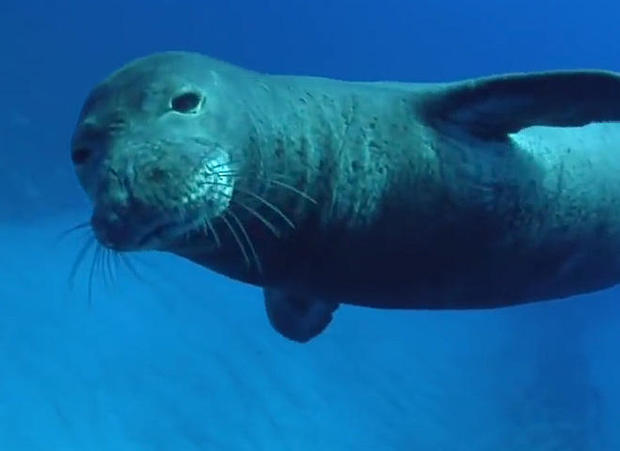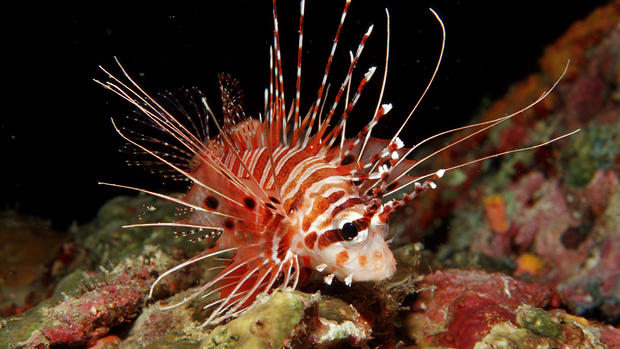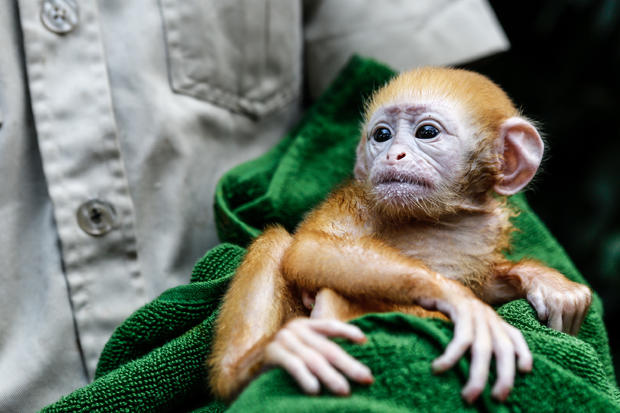How Many Animals Die Each Year From Global Warming
1 1000000 species of plants and animals at run a risk of extinction, U.N. written report warns
People are putting nature in more trouble now than at whatever other time in human history, with the adventure of extinction looming over 1 meg species of plants and animals, scientists said Monday. But information technology'due south not too tardily to fix the problem, co-ordinate to the United Nations' showtime comprehensive report on biodiversity.
"We have reconfigured dramatically life on the planet," report co-chairman Eduardo Brondizio of Indiana University said at a printing conference.
Species loss is accelerating to a charge per unit tens or hundreds of times faster than in the by, the report said. More than one-half a million species on land "accept insufficient habitat for long-term survival" and are likely to become extinct, many inside decades, unless their habitats are restored. The oceans are not whatsoever better off.
"Humanity unwittingly is attempting to throttle the living planet and humanity's ain future," said George Mason University biologist Thomas Lovejoy, who has been called the godfather of biodiversity for his research. He was not function of the written report.
"The biological diversity of this planet has been actually hammered, and this is actually our last chance to address all of that," Lovejoy said.
Patricia Miloslavich, a contributor to the report and senior professor in the Section of Ecology Studies at Universidad Simón Bolívar, spoke with "CBSN AM" on Monday about the conclusions.
"We have seen in the past that history has taught the states at that place have been mass extinctions. This, however cannot be considered a mass extinction. This is just a loss of species at an unprecedented rate due to human intervention," she said. "The drivers of this species loss and ecosystem loss is our extreme changes in the utilise of the land and the oceans."
Conservation scientists from effectually the world convened in Paris to issue the written report, which exceeded 1,000 pages. The Intergovernmental Science-Policy Platform on Biodiversity and Ecosystem Services (IPBES) included more 450 researchers who used 15,000 scientific and government reports. The report's summary had to be canonical by representatives of all 109 nations.
Some nations hit harder by the losses, like small isle countries, wanted more than in the report. Others, such every bit the U.s.a., were cautious in the linguistic communication they sought, simply they agreed "nosotros're in trouble," said Rebecca Shaw, chief scientist for the World Wildlife Fund, who observed the terminal negotiations.
"This is the strongest call we've seen for reversing the trends on the loss of nature," Shaw said.
The findings are not just about saving plants and animals, but most preserving a world that's becoming harder for humans to live in, said Robert Watson, a former summit NASA and British scientist who headed the report.
"We are indeed threatening the potential food security, water security, human health and social fabric" of humanity, Watson told The Associated Press.
It's also an economic and security effect as countries fight over scarcer resources. Watson said the poor in less developed countries bear the greatest brunt.
The written report's 39-folio summary highlighted five means people are reducing biodiversity:
Overfishing the world'due south oceans. A third of the world's fish stocks are overfished.
- Permitting climate change from the burning of fossil fuels to make it besides hot, wet or dry out for some species to survive. Almost half of the globe'southward land mammals — not including bats — and nearly a quarter of the birds have already had their habitats hit hard by global warming.
- Polluting land and h2o. Every year, 300 to 400 million tons of heavy metals, solvents and toxic sludge are dumped into the world'due south waters.
- Allowing invasive species to crowd out native plants and animals. The number of invasive alien species per country has risen 70% since 1970, with one species of bacteria threatening nearly 400 amphibian species.
"The key to remember is, information technology's not a terminal diagnosis," said report co-author Andrew Purvis of the Natural History Museum in London.
Marine biologist Jon Witman from Brown University, who travels to the Galápagos Islands regularly to monitor the furnishings of climate change on local species, spoke about the threat in the recent CBSN Originals documentary, "Adapt or Die: Tin can Evolution Outrun Climate change?"
"There's no doubtfulness we are in an unprecedented period of global stress in terms of climate impacts. And basically the natural globe is being hit by what I call the big 3. Certainly climate change is upwards there. Habitat devastation by humans is admittedly key. And we're also adding pollution to the ecosystem. Information technology sounds pretty grim, and it is grim," Whitman said.
Professor Miloslavich told CBS News that what's happening in the world today is dissimilar than the natural process that led some species to go extinct in by eras.
"Information technology's true there have been extinctions in the by, that nature has taken its course, information technology'southward only that these accept been processes that have taken millions of years and nature has had the fourth dimension to accommodate and provide a response," she said. "Nosotros are not giving nature a fourth dimension to provide a response."
Fighting climate change and saving species are every bit of import, the written report said, and working on both environmental problems should go manus in hand. Both problems exacerbate each other considering a warmer world means fewer species, and a less biodiverse earth ways fewer trees and plants to remove heat-trapping carbon dioxide from the air, Lovejoy said.
— Turning forests, grasslands and other areas into farms, cities and other developments. The habitat loss leaves plants and animals homeless. About 3-quarters of Earth'southward land, two-thirds of its oceans and 85 pct of crucial wetlands have been severely contradistinct or lost, making it harder for species to survive, the report said.
The world's coral reefs are a perfect case of where climate change and species loss intersect. If the earth warms another 0.ix degrees (0.v degrees Celsius), which other reports say is probable, coral reefs will probably dwindle by 70 percent to 90 percent, the report said. At 1.eight degrees (1 degree Celsius), the report said, 99% of the earth'south coral will be in problem.
"Business organization as usual is a disaster," Watson said.
At least 680 species with backbones have already gone extinct since 1600. The report said 559 domesticated breeds of mammals used for food have disappeared. More than 40% of the world's amphibian species, more than one-third of the marine mammals and about 1-tertiary of sharks and fish are threatened with extinction.
The report relies heavily on research by the International Marriage for the Conservation of Nature, or IUCN, which is composed of biologists who maintain a list of threatened species.
The IUCN calculated in March that 27,159 species are threatened, endangered or extinct in the wild out of nigh 100,000 species biologists examined in depth. That includes 1,223 mammal species, 1,492 bird species and 2,341 fish species. Well-nigh half the threatened species are plants.
Scientists have only examined a small-scale fraction of the estimated viii million species on Earth.
The written report comes upwardly with 1 million species in trouble past extrapolating the IUCN's 25 percent threatened rate to the rest of the world's species and using a lower rate for the estimated 5.5 million species of insects, Watson said.
Exterior scientists, such as Lovejoy and others, said that's a reasonable cess.
The report gives only a generic "within decades" time frame for species loss considering it is dependent on many variables, including taking the problem seriously, which can reduce the severity of the projections, Watson said.
"We're in the center of the 6th keen extinction crisis, merely information technology'south happening in dull motion," said Conservation International and University of California Santa Barbara ecologist Lee Hannah, who was not part of the written report.
Five times in the past, Earth has undergone mass extinctions where much of life on the planet blinked out, like the ane that killed the dinosaurs. Watson said the written report was careful not to telephone call what'due south going on now as a sixth big die-off considering electric current levels don't come shut to the 75% level in past mass extinctions.
The report goes beyond species. Of the eighteen measured ways nature helps humans, the report said 14 are declining, with nutrient and energy production noticeable exceptions. The report found downwards trends in nature's ability to provide make clean air and water, good soil and other essentials.
Habitat loss is one of the biggest threats, and it'south happening worldwide, Watson said. The report projects 15.v million miles (25 million kilometers) of new roads volition exist paved over nature between now and 2050, virtually in the developing globe.
Many of the worst effects can exist prevented by irresolute the way we grow food, produce energy, deal with climate modify and dispose of waste matter, the report said. That involves concerted action by governments, companies and people.
Individuals can help with simple changes to the way they swallow and use energy, said the co-chairman of the report, ecological scientist Josef Settele of the Helmholtz Center for Ecology Research in Germany. That doesn't mean becoming a vegetarian or vegan, but balancing meat, vegetables and fruit, and walking and biking more, Watson said.
"Nosotros can actually feed all the coming billions of people without destroying some other inch of nature," Lovejoy said. Much of that can be washed by eliminating nutrient waste and beingness more than efficient, he said.
Thanks for reading CBS NEWS.
Create your free business relationship or log in
for more than features.
Source: https://www.cbsnews.com/news/report-1-million-animals-plant-species-face-extinction-due-climate-change-human-activity-population/
Posted by: parrishthioseen.blogspot.com




0 Response to "How Many Animals Die Each Year From Global Warming"
Post a Comment